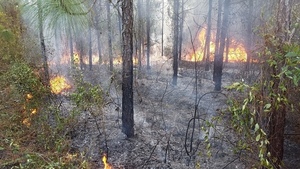Anybody else had to get one of these?
Thanks to Adel Tire for the fix, including a new inner tube.
-jsq
Anybody else had to get one of these?
Thanks to Adel Tire for the fix, including a new inner tube.
-jsq
Back in the 1930s, during the Great Depression, my father and grandfather paid off the mortgage on the farm through income from turpentine. This is a catface, where the bark was scraped off a pine tree so its sap would ooze out, to be caught in a metal cup nailed below on the tree.
The rest of the tree long ago was logged.
Behind the pine tree stump and the adjoining oak tree, you can see a beaver pond. Continue reading
The firebird appears to be a Carolina wren.
This Thryothorus ludovicianus didn’t seem to mind that I was three feet from it. Continue readingUpdate 2020-05-10: Phoenix bird 2020-05-10
Firebird:
We burned on March 2, 2020, and that tree Continue reading
Dogs like water more than fire.
![[Yellow Dog and camouflaged Brown Dog]](http://www.okraparadisefarms.com/pictures/2020-03-02--burn-cont-swamp-boat/20200302_130718.jpg)
Yellow Dog and camouflaged Brown Dog
And yes, Gretchen was putting out fires with a coffee cup and swamp water.
But she found something unexpected. Continue reading
Gretchen and the LeConte Pear tree.
We might get some pears this year.
Thanks to the cousin who gave this tree to us.
And the nineteenth century cousin who found it. Here’s a story about that. Margie Love, Coastal Courier, originally 16 September 2007, updated 26 September 2011, Liberty’s LeConte pear was once famous.
-jsq
When you live in a fire forest, you must burn every few years. We caught up on about 23 acres of burning of piney woods, seepage slope, and swamp. All this was inside concentric rings of firebreaks, with no danger of it escaping off our property.
Don’t worry, for the wildlife there are plenty of brambles and woods and swamp unburned this year. More next year. And quail, gopher tortoises, and other wildlife don’t like the woods too thick anyway.
![[Gretchen spreading fire with a rake]](http://www.okraparadisefarms.com/pictures/2020-03-01--burn/20200301_121754.jpg)
Gretchen spreading fire with a rake
For why we burn, see Continue reading
A very tiny spring or seep.
Brown Dog thinks it’s a puddle, but it never goes dry.
Next to it is a sycamore tree.
Gretchen likes sycamores.
-jsq
Here’s why we should have burned this patch last year, but unfortunately weather didn’t cooperate.
![[Why frequent burning is necessary]](http://www.okraparadisefarms.com/pictures/2020-02-24--burn/20200224_143426.jpg)
Why frequent burning is necessary
If we didn’t burn, eventually what we’d get would be an uncontrolled wildfire with much worse flareups than that.
Somebody always complains about burning woods. Let the Longleaf Alliance explain the benefits of fire in a southern pine forest.
It started easy this year. Continue reading
 Less than an acre of planted pines, never burned since planted ten years ago.
Lit right up, burned real nice.
Less than an acre of planted pines, never burned since planted ten years ago.
Lit right up, burned real nice.
Here are some videos, and there are pictures below. Continue reading